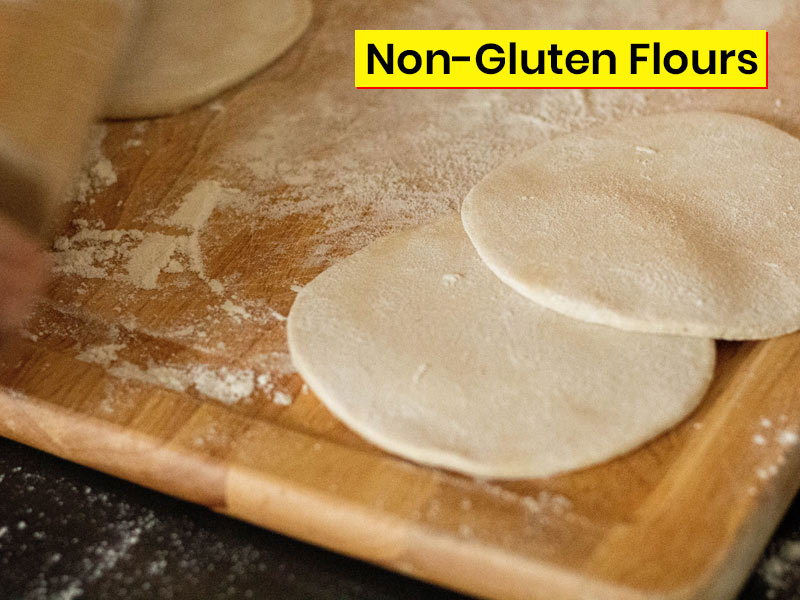
Wheat is a staple grain in India, especially in the northern region. This nutritious foodgrain contains all the three macronutrients, carbohydrates, fats and proteins in good amounts, along with fiber and several vitamins and minerals, such as selenium, manganese, copper and folate. Although unproblematic for most, some people cannot eat it. And there is one protein that is at the centre of it all: gluten.
Table of Content:-
Gluten is a family of proteins. Although most widely found in wheat, it is also present in other grains such as barley and rye. The public opinion regarding it is widely divided. Some believe it is bad for health, others say it has no adverse effects. However, according to some experts, you can have gluten, unless you have celiac disease, gluten sensitivity, or other such conditions. Since a significant portion of our diet comprises flour, it is crucial to explore some non-gluten varieties. But before we delve into it, let us look at some symptoms of gluten intolerance.
Symptoms Of Gluten Intolerance

(Photo Credit: Freepik)
Celiac disease, gluten sensitivity, and wheat allergy together comprise gluten intolerance. If a person suffering from it consumes wheat, he/she can experience the following symptoms, as enlisted by a leading health website:
- Diarrhea or constipation
- Bloating
- Stomach pain
- Skin rashes
- Anemia
- Weight loss without any proper reason, which often happens in the case of undiagnosed celiac disease
- Fatigue
- Headache
- Muscular and joint pain
- It can even cause depression and anxiety
Also read: Gluten-Free Pizza Recipe: How To Make Healthy Millet Pizza At Home?
Non-Gluten Flours
As you saw that some people cannot eat gluten, hence there is a need for wheat substitutes. To know this, Onlymyhealth spoke to Sreemathy Venkatraman, Clinical Dietitian & Wellness nutritionist and founder of ‘Mithaahara - Eat to live’. Here is what she recommends:
Emmer Wheat (Khapli)

(Photo Credit: Freepik)
- It is non-gluten wheat.
- 100 grams of it contains 340 calories and 13.2 grams of protein.
- This wheat has proved to be good for diabetes and heart patients.
- Since it has a high satiety value, it is good for weight loss.
- Its high fiber content (10.7 grams/100 grams) makes it ideal for those having constipation.
- Its one flaw is that it can be difficult to digest for some people.
Sorghum (Jowar)
- 100 grams of sorghum flour contains 329 calories and 11 grams of protein.
- It is high in fiber and mineral iron.
- It also contains antioxidants that can help prevent inflammation.
Finger Millet (Ragi)
- 100 grams of finger miller or ragi flour contains 354 calories and 13 grams of protein.
- Not only it is high in protein, but it is also rich in antioxidants.
- It is also believed to be good for diabetics and for heart health.
- It is rich in calcium and fiber.
Amaranth (Rajgira)
- 100 grams of Amaranth flour contains 371 calories and 14 grams of protein.
- Not only is it rich in protein, but it is also high in fiber and essential nutrients such as iron, magnesium, phosphorus, and magnesium.
Also read: Buckwheat Is The Best Gluten-Free Cereal, Know Buckwheat Health Benefits
Pearl Millet (Bajra)
- 100 grams of bajra flour consists of 201 calories and 6 grams of protein.
- It is rich in carbohydrates and also contains decent amounts of fiber and other vital nutrients and minerals, such as iron and zinc.
- Not only that, but it is also rich in antioxidants and polyphenols.
Jackfruit Flour
- 100 grams of this flour contains 157 calories and 2.8 grams of protein.
- As per The American Diabetes Association, this flour can help in managing diabetes.
- It is low in carbs and high in fiber, which can help those suffering from constipation.
These are some of the flours you can include in your diet if you have gluten intolerance. Even if you don’t have it, you can try these for a change in taste and their several health benefits.
(With inputs from Sreemathy Venkatraman, Clinical Dietitian & Wellness nutritionist and founder of ‘Mithaahara - Eat to live’)
Photo Credit: Pixabay
Also watch this video
How we keep this article up to date:
We work with experts and keep a close eye on the latest in health and wellness. Whenever there is a new research or helpful information, we update our articles with accurate and useful advice.
Current Version